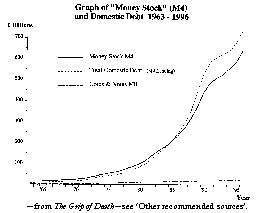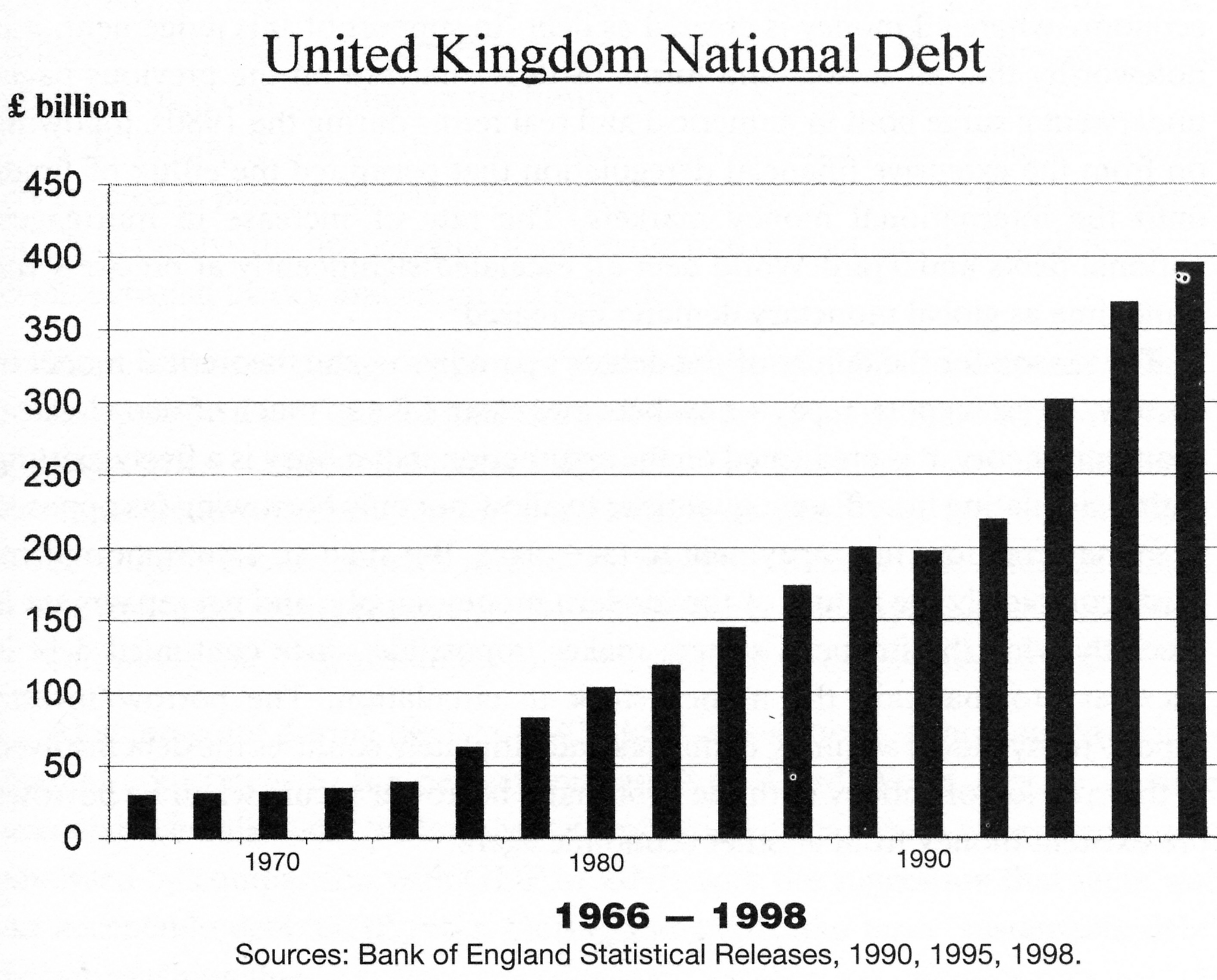
Below is the substance of the leaflet I wrote and printed to distribute at last December’s Climate Change march in London:
12
The Cost of Climate Change …?S
ince the start of the industrial revolution, the mantra of ‘economic growth’ has been consuming the world’s natural wealth at an ever-increasing rate. Crunch time is NOW, with the threats not just of climate change, but of ‘peak oil’, pollution of soil, air and the oceans, and near-exhaustion of a growing list of raw materials.This ‘economic growth’ has long ago passed the point of the ability to meet everyone’s needs, adequately. Yet every nation is still seeking it, and competing fiercely with every other nation to export – and to import ‘investment’, not real wealth!
We are drowning in debt, yet being urged to spend, to keep the system growing. Why is this?
The World is being driven to destruction by the results of the way our money enters circulation. This is a subject deliberately kept out of public discussion by those in control, since if it were widely understood, it would not be allowed to continue!
Debts have been growing ever-faster since the system started, as a direct result of the nature of the system. They are the driving force behind the ‘need’ for everlasting ‘economic growth’ and ‘globalisation’: the basic cause of climate change. Why is this happening?
Looking at the physical realities: the prime problem is not shortage of goods/services for sale, but waste of them, and the distribution of entitlement to them; grossly unfair distribution of money. Fast-growing debts cause desperate competition for ‘jobs’ to secure income and to ‘service’ the debts.
The myth promoted is that when a bank makes a loan, it is lending deposits of money it holds in customers’ savings accounts. This does not explain how the volume in existence has been constantly growing. The fact is that when a bank makes a loan, it is creating new money! – but also an interest-bearing debt.
The borrower gets a ‘credit’ – money – to spend into circulation, but also an interest-bearing debt, which remains with the borrower until it is redeemed, at which point the principal of the loan is cancelled out of existence, but the interest has to come from other money which has similarly been created along with an interest-bearing debt. Until the bank spends the interest, this also is out of circulation, leaving less for other debts to be redeemed, unless more loans are being taken out.
This means that the money supply must keep growing, if the system is not to collapse in unpayable debt. It also explains the constant ‘see-sawing’ between inflation and ‘depression’, as loans are alternately made freely, then restricted.
The interest on these debts – from all sections of society: individuals, companies and governments – goes on banks’ running costs and to increase their reserves, and on dividends to wealthy shareholders, who are likely to spend on antiques and luxuries, but also on dealing in shares and foreign exchange, derivatives, etc. – essentially, gambling; extracting wealth from the producers. This draws money out of the production/consumption system, and is further worsened by the widespread use of large loans of bank-created money for this gambling, in which banks themselves now engage, since Thatcher’s deregulation of them.
Because of this, the extremes of wealth and poverty are growing, while commercial firms are desperate to expand to service their loans and remain in profit, and people are desperate to ‘earn a living’ and governments to ‘create employment’. All this leads to gross waste of materials in the ‘planned obsolescence’ of deliberately unrepairable, short-life goods, constantly changing fashions and huge efforts in advertising to promote all this and keep demand growing.
Banks having the power to issue loans gives them great power over the economy, being able to decide who will get these loans, for what purpose. Their prime concern is the borrower’s ability to repay, with interest, and not the social value of the purpose of the loan. Armaments are considered far safer than renewable energy!

The truth is that, over the last several centuries, the system has been manipulated by the top bankers and industrialists for their own wealth and power. A mixture of bribery of politicians, false claims and fraud, then made legal, funding of tame economists and ownership of the public media to filter and distort the news and avoid debate on crucial issues has led to the devastating ‘third world’ debts and the promotion of ‘globalisation’.
For many centuries, money was mainly the creation of the State, with only minor supplements by private interests. Money created by the State is spent into circulation, and so enters it without creating debt. The State gets its face value, less the cost of creation. This is known as the seigniorage.

Since the founding of the then-private Bank of England in 1694, the banks have gradually increased their share of money creation, as ‘credit’. Just after the last World War, the notes and coins, created and spent into circulation by the State, still formed about half of the money supply, but because of the reducing use of these and the increase instead of credit, this now forms over 97% of our money. As a result, with the increase of debt, the system is now threatened with total breakdown, as debt repayment and interest charges impose increasingly unsupportable demands. Whole countries have had major breakdowns of their ‘economies’ as a result, and the USA, now the world’s largest debtor nation, is on the verge of collapse, with results seriously affecting most of the rest of the world.
Movements for reform have been in existence for at least the last two centuries, and are again growing fast. In essence they argue that the State should take back the sole right to create our national money, with banks restricted to doing what they now pretend to do: only lend out money they already have!
If this change is made, then as outstanding debts are cleared, new money must enter the system to replace them; this must be by government spending, not bank-debt creation. This would over time reduce the levels of debt to insignificance.
If much of the new money was used to fund Basic Incomes – payments to all, unconditionally, of enough to support a modest standard of living – this would free people to choose their own way of life: negotiate acceptable terms of employment or leave unethical businesses (telesales, arms manufacture, armed forces, etc.), to work on the changes to renewable energy, become self-employed, form cooperatives, enjoy leisure, become politically active, care for family, friends, and their locality, etc.
If each country made this change to its national currency, it could fund its people to produce for its ‘home market’ all that its skills and resources allowed. Existing international debts should be cancelled; then international trade should be for mutual benefit.
Genuine surpluses should be given to countries in need; knowledge and skills should be freely exchanged. Without the debt-pressure, cooperation could and should flourish, with competition playing only a minor role in human affairs.
Even with the recent huge growth in human population, experts estimate that, given fair distribution, no-one need starve. Elimination of the false debts could allow rapid development of low-energy lifestyles, essential to minimise climate change.

A fuller outline of these ideas is in my booklet, Where’s the Money to Come From??, available for 3 second-class stamps, from me, Brian Leslie, at 12 Queens Road, Tunbridge Wells, TN4 9LU, or view an earlier version on my website,
www.sustecweb.co.ukOther recommended sources: Ellen H Brown, The Web of Debt, Third Millennium Press, 2007 ISBN 978 0 9795608 0 4 (just published) – 524 very readable pages covering the disastrous development of the ‘web’ of the global money-power and the efforts by politicians and others to counter it over the past centuries, and how we can break free. Focusing mainly on the developments in the USA, since these are most clearly documented and show most clearly the struggle and need for reform, and covering also its dominant relationships with Europe and the rest of the world, and the UK’s part in the origins of central banking. Very fully referenced.
www.webofdebt.com;a DVD, Money as Debt, from Canada, by Paul Grignon, outlines in cartoon form in 47 minutes the way the modern debt-money system developed, its effects and possible reforms.; available from me for £3.50. www.moneyasdebt.net;
Stephen Zarlenga, The Lost Science of Money: The Mythology of Money – the Story of Power. Survey from ancient times to the present, highlighting the deliberate mystification about the nature of money for exploitation of the system. American Monetary Institute, 2002 ISBN 1-930748-03-5
www.monetary.org;Michael Rowbotham, The Grip of Death, A study of modern money, debt slavery and destructive economics. Traces the influence of the debt-pressures deriving from the money-creation process on the development of the modern, destructive economy… Jon Carpenter Publishing, 1998 ISBN 1 897766 40 8(see below);
Michael Rowbotham,
Goodbye America! Globalisation, debt and the dollar empire Publ. May
2000 ISBN 1 897766 56 4 - Explores the relation of Third World debt to
globalisation, to the debt-money system, and to the issue of political power.
£11 Post free in the UK from Jon Carpenter Publishing, Direct Sales Dept., 2
Home Farm Cottages, Sandy Lane, St. Paul's Cray, Kent BR5 3HZ (Add 10% for
Europe, 20% ROW) Visa/Mastercard by phone:
01689 870437
– Brian Leslie